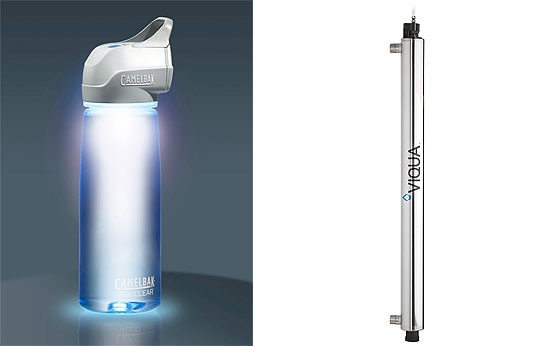Ultraviolet UV Water Purification And How It Works

A highly effective method for home water disinfection. A ultraviolet light (UV) system.
It’s technically not a water filter. It doesn’t filter out anything by ‘capturing’ particulate contamination in a filter media. Rather, a UV (Ultraviolet) works by ‘zapping’ organic pathogens that may be in the water supply.
The method (the science) even works by natural sunlight (albeit much slower).
[ Read: How To Purify Water With Sunlight ]
How It Works
UV (ultraviolet) light ‘inactivates’ pathogenic micro-organisms. The UV light disrupts their DNA. They can no longer reproduce.
In fact, the method has been around for many years. ‘Developing’ countries around the world use the ‘SODIS’ method for water purification. (Solar Water Disinfection).
The WHO, UNICEF, and the Red Cross recommends SODIS. All it requires is sunlight and PET or clear glass bottles. How does it work? Fill Clear bottles with water and set them out in the sun for 6 hours. The UV-A rays in sunlight kill germs (e.g. viruses, bacteria, parasites, giardia, cryptosporidia).
SODIS taken to the next level…
The same principle is now being applied via ‘high-tech’. Ultraviolet (UV) lamps achieve the same results of water disinfection. But much quicker! Nearly instantaneous. They emit UV-C or “germicidal UV” radiation of much greater intensity than sunlight.
Geek alert: Almost all of a UV lamp’s output is concentrated in the 254 nanometers (nm) region in order to take full advantage of the germicidal properties of this wavelength.
These UV lamps are made in varying sizes. Some are designed for portability / water bottles:
>> UV Water Filter Bottles
(view on amzn)
…or whole-house UV water systems
>> UV Water Filters – Whole House
Other types of water purification systems use chemicals or very fine screens to clean water. While these methods are effective, bacteria and viruses can slip through all but the finest screens. Apparently no known bacteria or viruses are immune to ultraviolet light.
TIPS:
If your water is turbid (cloudy). The UV disinfection will be inhibited to an extent. Cloudiness from solids in the water may protect the bacteria and viruses from the ultraviolet light.
Consider installing a sediment filter (5 microns or less) ‘upstream’ from the UV system.
If your water hardness over 7 grains, you should install a water softening device in front of your unit. Hard water will eventually leave a calcium/magnesium film which may reduce or block the UV rays.
